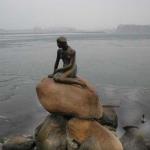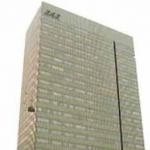Sights Copenhagen, Denmark
 Center of Copenhagen is n loschad City Hall, which is located a stone with a mark of 0 km. Town Hall building itself, it is noteworthy original thermometer. In good weather there is the figure of a girl on a bicycle, and in bad - the same girl with an umbrella in hand. Here, in the area are unusual Fountain of bull, rending the Dragon "and the pedestal with the two Vikings-troubadours. Legend has it that they shall blow, when the past is just an innocent girl, but while the sounds of pipes have not been heard.
Center of Copenhagen is n loschad City Hall, which is located a stone with a mark of 0 km. Town Hall building itself, it is noteworthy original thermometer. In good weather there is the figure of a girl on a bicycle, and in bad - the same girl with an umbrella in hand. Here, in the area are unusual Fountain of bull, rending the Dragon "and the pedestal with the two Vikings-troubadours. Legend has it that they shall blow, when the past is just an innocent girl, but while the sounds of pipes have not been heard.Town Hall Square starts the oldest and longest pedestrian zone in Europe - Stroget (in Danish "stroget" means "walk"). The word "Stroget" never appears on the map of Copenhagen, as Stroget includes several into one another, the streets of old town. As befits a pedestrian street, Stroget dotted with cafes and restaurants, souvenir shops and luxury shops, entertaining passers-by, clowns and street musicians. Here, as elsewhere, life pulsates around the clock and the air is saturated with the holiday.
Quarters on both sides of Stroget you discover many interesting things: this is an ensemble of ancient University of Copenhagen, and numerous medieval churches and cozy but crowded area with narrow, ancient streets, where according to legend, are found to bring. However, they did not meet everyone.
After a fascinating walking Stroget bring you to the most spacious in the city of New Royal Square (Kongens Nytorv). Here are founded in 1722, the Royal Theater and the Academy of Arts exhibition rooms, housed in a former royal residence Sharlottenborg. Here is the most chic hotel in Copenhagen - d'Angleterre, from the window of which Hans Christian Andersen saw the skating rink, as described in "The Snow Queen".
Very near to this area is one of the most elegant areas of Copenhagen - Nyhavn. This is a picturesque canal with a kilometer long, 15 meters wide. He was dug in 1671 to bring water Oresund Strait to the New Royal Square. In those days there were lit in the main red lights. Today, this area - is an endless series of neat little houses and the beautiful color of sailing ships, swaying peacefully in the narrow channel. It is in this area are the most expensive "tourist" restaurants and cafes.
Incidentally, the homes of N 20 and 67 on the canal Nyhavn can read that here in the years lived and worked Hans Christian Andersen. There is in Denmark's capital and some monuments Andersen. The first was established in 1880, shortly after his death, the Royal Garden. Danes immortalized the name of Hans Christian Andersen, not only in the monuments, street names, theaters, restaurants, and even ... sandwiches.
After strolling through the canal Nyhavn along the embankments can be traced to the most beautiful royal residence Amalienborg (this is why we began the march naked king). The ensemble of 4 identical palaces, forming octagonal square, you can view only partially, but still at noon attracts curious to see the ceremony of changing of the royal guard - one of the favorite of all shows in the capital. If the queen is currently in the palace, then it rises above the flag and changing of the guard in the square is on a large ceremonial.
This area of Copenhagen is famous not only palaces, but Marble Cathedral (1894). It is the largest cathedral in Scandinavia. Its uniqueness lies in the fact that this is the only round in terms of the church. Due to lack of money during the construction of Marble in the cathedral is made of painted wood.
Near the Marble Cathedral rises zlatoglavaja Russian Orthodox Church of Alexander Nevsky (1864). It was built for the staff of the Embassy of Russia and almost annual visits to Denmark, the royal family.
While in Copenhagen, one can not come to Denmark's most famous attractions - the heroine of Hans Christian Andersen, Little Mermaid, although, in truth, no it is nothing too special. Several times Danish vandals repulsed by the Little Mermaid's head, then neck it appeared rough welded seam. Incidentally, in the Crimea in the Black Sea is an exact copy of the Little Mermaid.
Two steps from the Little Mermaid is the largest fountain in Copenhagen "Gefion", named after a Norse goddess. According to legend, she enchanted the Swedish king, who promised to give her as much land as she could dig up for the night. Gefeon turned his sons into bulls and plowed the island of Zealand, on which Copenhagen is located. Here it should be noted that Denmark - this island country. It is situated on 406 islands, only 90 of which are inhabited, and the Jutland peninsula.
Further our path lies in the area Slotsholmen. On this small island and appeared in Copenhagen in 1167. The most heart of the city, coupled with the rest of the small bridges. The main attraction - Hristiansborg Palace (Christiansborg Slot), built in 1730, as another royal residence. Under the palace were discovered the ruins of early castles, including the very first, pledged Bishop Absalon, founder of the city, in the XII century. Now settled in the palace of the Danish Parliament (Folketing) and the Supreme Court of Justice. In one of the wings of the palace as a museum located Arsenal with collections of old clothes, carriages and weapons.
Near the palace is the Royal Library and Museum of the sculptor Bertel Thorvaldsen from exposure (in the original or plaster copies) of all, ever created his sculptural works. Himself Thorvaldsen is buried here.
Indulge in the pleasure of a stroll on the most famous theme park, Denmark - Tivoli (Tivoli). This park, which is one of the main attractions of Copenhagen, was opened back in 1843. It affects myriad cafes and restaurants, but few attractions, widely advertised in many guidebooks, few people are surprised. But they do not attract tourists. It is decorated with a huge number of flower beds, and more than a hundred thousand electric lamps (not the neon light!), Creating an impressive landscape. The park also is a beautiful palace of Tivoli, many fountains, small lakes with swans, public theaters and concert halls. In the summer a few times a week in Tivoli satisfied with colorful fireworks.
Also noteworthy Round Tower (Rundetaarn) with a gold emblem on the facade. The tower was built in 1642 to house the ancient astronomical observatory, University of Copenhagen. Her height - 36 m, and inside the tower - a unique spiraling rise in the length of 209 m, which in 1716 the guest of the Danish capital of Peter I rode up to the top on horseback, accompanied by a carriage with Queen Catherine. In 1929, on top of the tower set up a revolving dome, with a platform which you can admire the panorama of Copenhagen, with its red-tiled roofs and green spikes of numerous towers.
Walking in Copenhagen, be sure to visit Rosenborg Castle (Rosenborg Castle) with its original finish. Rosenborg Castle (1632) is surrounded by a small park and is famous for its Museum of the Danish kings (1858), with a remarkable collection of the royal family jewels and excellent art exhibition.
Instead Rosenborg Castle is a beautiful landscaped park. Emerged in the XIX century on the site of the demolished fortifications, Botanical Garden takes about ten hectares. His collection, in the first place, gives an idea of the Danish flora. Among the greenery, statues and fountains in the Botanical Garden stands a grand palm conservatory, set in 1874 for tropical trees, obviously not suitable climate of Copenhagen.
Located on the island of Amager quarter Christianshavn its canals and picturesque old buildings like Amsterdam in miniature. You can visit the Royal Naval Museum with more than 300 mock-ups of old ships and the Church of the Savior (For Fresers Kirke). On the outer wall of the church is up a spiral staircase outside of the 400 steps, climbing on which you can enjoy the unforgettable panoramic view of Copenhagen.
Nearby is one of the most shocking places of the capital of Denmark - Christiania. This is a unique area of Copenhagen, as he did not, perhaps, nowhere else in Europe. District amazes newcomers immediately: only a few dozen meters from the main entrance from the street Prinsessegade, is a brisk trade in so-called soft drugs - marijuana, hashish, various grass. In the original flower shops you can buy a pot of live cannabis (actually, nothing else there and not buy). But because places like Christiania shelter the homeless and drug addicts, he tried not to show to foreign tourists. (Travel by bus number 8 of the Town Hall Square).
As in Denmark, one can not walk to the castles of the kingdom.
Kronberg Castle is the main attraction of the city Elsinore (40 km from Copenhagen), but it can not be called a romantic place, too he is lonely and gloomy.
Its gates are reliefs depicting women with skulls in their hands, and over the heavy wooden doors hang mugs terrifying monsters. It was this castle was the scene of Shakespeare's "Hamlet", even despite the fact that in Kronberg never lived kings. Now Kronborg houses the Museum of navigation and trade. In addition, you can visit the most beautiful halls: The Knights' Hall and Chapel, and visit dungeons.
Frederiksborg Castle (Frederiksberg) is located north of the capital - in Hillerød on three small islands in the middle of the lake, and is famous for its interiors and the Knight's Throne Halls, and, miraculously survived the fire, the Castle Church. Surrounding the castle park Frederiksberg Have. Here's a special atmosphere. Walk through the park you will probably like it very much. Emerald lawns, shady avenues, tall oaks and elms. Figure lake, many birds, ducks and swans. You can ride on the boat. The oars sits descendant the boatman who transported a resident here of King Frederick VI. This explains the privilege to roll people, given the boatman and his descendants. To the west of the castle is one of the best zoos in Europe.
